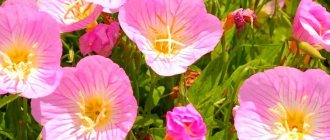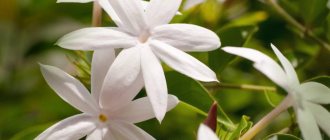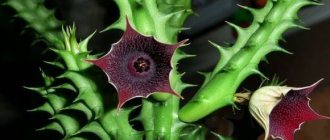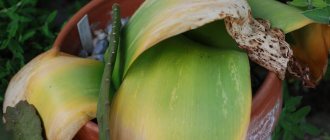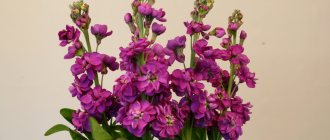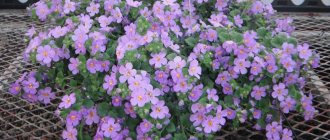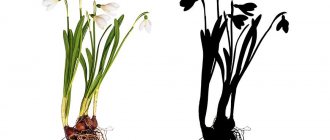Xeranthemum is an annual herbaceous dried flower plant that belongs to the Asteraceae or Compositae family. Other names of the plant: annual dried flower, annual dried flower, immortelle. The genus is represented by 6 species, but only one is cultivated - annual xeranthemum (Xeranthemum annuum).
The height of the plant is no more than 60 cm. The stems are erect, covered with pubescence, which gives them a silvery tint. The leaf blades are lanceolate-shaped, their length is about 3 cm, they are petiolate, arranged alternately, and also covered with villi.
In the natural environment, xeranthemums grow in Asia Minor, the Mediterranean, the southern and western parts of Europe, and the Balkans. Habitats are steppes, dry slopes and low mountains, chalk outcrops, sandstones.
Xeranthemum has been cultivated culturally since the end of the 18th century. For decorative purposes, it is grown in flower beds; the inflorescences are used to make live and dry bouquets. Xeranthemum is a seasonal plant (cultivated only as an annual plant). The beauty of the inflorescences, which persist even after drying, and the unpretentiousness of propagation and care contributed to the popularization of the plant.
Growing xeranthemum from seeds
Xeranthemum seeds photo
Reproduction of xeranthemum is exclusively generative (seed).
Growing seedlings
In order for flowering to begin as early as July, seedlings will need to be grown. Start sowing at the end of March. Take a shallow container (about 10 cm high), fill it with a nutrient substrate (use a soil mixture intended for growing seedlings), distribute the seeds over the surface of the moistened soil, the seeding depth should be no more than 0.5 cm.
Xeranthemum from seeds photo shoots
Cover the top of the container with the crops with transparent glass or oilcloth; they will need to be lifted daily for ventilation. It is necessary to provide warmth (within 22-25 °C) and bright, diffused lighting, and periodically moisten the crops. When sprouts appear, the cover must be removed. At the stage of appearance of two true leaves, you will need to plant the xeranthemums in separate containers; proceed carefully so as not to damage the root system.
Xeranthemum growing from seeds photo seedlings
Further care consists of maintaining soil moisture and providing bright, diffused lighting. When the seedlings take root and begin to grow, they should be hardened off before planting in the ground. Take it out into the garden or onto the balcony for 10-12 days so that the plants get stronger and get used to open ground conditions. When warm weather sets in without night frosts, seedlings can be planted in a flowerbed without fear that the plants will get sick.
Sowing in open ground
Xeranthemum seeds are sown in open ground from mid to late May, but keep in mind that flowering will occur almost a month later. Make grooves about 3 cm deep, pour warm water over them, let them soak, distribute the seeds, and cover with soil. To speed up the germination process, cover the top with film.
For successful seed germination, the air temperature must be about 20 °C; they can die even with light frosts. Strong sprouts can withstand temperatures down to +5 °C. Still, there are cases when seeds germinate after wintering in open ground. Intentional sowing of xeranthemum before winter is possible only in regions with warm, mild winters.
Botanical description
Xeranthemum is an annual plant that belongs to the Asteraceae family. It began to be grown at home at the end of the 18th century in the southern regions of Europe, but it soon spread throughout the world, thanks to its unpretentiousness to growing conditions and its unusual beauty, which remains even after drying. The flower is characterized by the presence of an erect stem, which can reach a height of 60 cm. Narrow, long lanceolate leaves are alternately planted on the stem. They reach about 3 cm in length and 0.5 cm in width. The stem is covered with white fibers.
The inflorescences look like baskets and are represented by hemispheres. Decorative species of this plant with double or semi-double inflorescences can be white, purple or pink. The flowers are small, no more than 3 cm in diameter. Blooms from early July to September. Flowering is friendly and abundant. The seeds on the flower ripen at the end of summer. The seeds are quite small, grayish, more than 700 pieces are concentrated in one gram, they remain viable for up to 3 years. The genus Xeranthemum has 6 species, but in floriculture only Xeranthemum annua is used.
Planting and caring for xeranthemum
Xeranthemum flowers planting and care photo in the garden
When to plant seedlings
Seedlings are transplanted into open ground at the end of May. Make holes, roll over the plant along with the earthen ball, press the soil around the seedling with your palms, the root collar should not go deep, but be flush with the soil surface. Keep a distance of about 20 cm between individual plants.
Caring for annual dried flowers is not difficult.
How to water
Regular watering will be required at the seedling stage and after planting in open ground. When the seedlings take root, water as the top layer of soil dries. When the budding period begins, watering should be stopped. Even during periods of severe drought, it is preferable to leave without watering.
How to feed
To stimulate flowering, feed the immortelle with complex mineral fertilizers, giving preference to the content of potassium and phosphorus. Follow the instructions on the package.
Periodically loosen the soil and clear the area of weeds. Be careful not to damage the roots.
Usage
Xeranthemum is planted in various flower beds, rockeries and rock gardens. Can be used in single or mixed plantings. Goes well with millennial, astrantia, salvia, etc.
Dried inflorescences can be used to create bouquets and decorate rooms. To do this, stems with buds that have not fully blossomed need to be cut, collected in bunches and hung in a dark room with good ventilation. Dried xeranthemums retain their color and shape for many years.
Chin (lat. Láthyrus) is a genus of herbs belonging to the legume family (lat. Fabaceae). The Latin name has Greek roots: “la”. Further
Nasturtium (lat. Tropaeolum) is a genus of herbaceous plants belonging to the Nasturtium family (lat. Tropaeolaceae). These beautifully flowering representatives of the flora. Further
In the plant kingdom there is an unpretentious plant of the borage family (Boraginaceae). A separate genus Blackroot (Cynoglóssum L.) has been identified in the family. Further
Eustoma (lat. Eustoma) or lisianthus looks extremely impressive in the garden; it is traditionally grown on an industrial scale for cutting. . Further
Ornamental cabbage (lat. Brassica oleracea var. acephala) is a variety of the species Garden cabbage (lat. Brassica oleracea), belonging to. Further
Amaranth or amaranth (lat. Amaránthus) is a genus of mainly annual herbaceous plants with dense spike-like paniculate inflorescences with. Further
Castor bean (lat. Ricinus) is a genus of perennial plants of the Euphorbia family (lat. Euphorbiaceae). Sometimes called castor. The genus is monotypic and . Further
Diseases and pests
Immortelle has high immunity to diseases and pests. Dampness (prolonged rainy weather, excessive watering) can cause rotting of the root system and stem. It is not possible to “cure” the plant, so monitor the level of soil moisture; during prolonged rains, you can even build a temporary shelter; loosen the soil more often so that it dries out faster.
The harms are few:
- The root-knot nematode is a microscopic worm that infects the root system. They settle in moist soil when the temperature ranges between 18-25 °C. Yellowish growths appear on the roots, the root system stops functioning, growth rates stop, leaf blades curl, and over time the plant dies. It is necessary to treat with an insecticidal preparation (for example, Phosfamide, Mercaptophos), following the instructions indicated on the package.
- Leaf aphids are small green or black midges. They feed on plant sap and eat leaves and flower buds. Aphids reproduce quickly and can very quickly destroy both young and adult plants. Act immediately: treat the plantings with an insecticide (Confidor, Aktara, Tanrek are suitable).
It is better to prevent unpleasant events than to deal with their consequences. Do not allow the soil to become waterlogged, do not thicken the plantings, and regularly remove weeds.
Xeranthemum in landscape design
Xeranthemum in landscape design photo
Xeranthemum is quite popular in landscape design because it has original beauty and is unpretentious in cultivation and care. It is used to decorate flower beds, rockeries, and border plantings. Group planting looks like natural vegetation, a lawn. Xeranthemum pleases the eye even after the end of the flowering period.
Suitable partners for xeranthemum are yarrow, salvia, astrantia, eschscholzia, and iberis.
Xeranthemum in floristry
Often, xeranthemums are specially grown to produce inflorescences for cutting; they look great in flower arrangements, both alive and after drying. If everything is done correctly, the shape of the buds and bright colors will remain for at least 2 years.
Cut when the buds have not yet fully opened. Collect the cut inflorescences into a bunch. Drying conditions: shaded, dry, well-ventilated area. Hang with the inflorescences facing down. There is a little trick. To make the inflorescences brighter after drying, treat them with a solution of hydrochloric acid. Take 12 parts of water and 1 part of hydrochloric acid, mix thoroughly, immerse freshly cut inflorescences (buds) in the liquid for 4-5 seconds. Then shake gently and leave to dry.
In bouquets, xeranthemum is combined with other dried flowers: kermek, helipterum, helichrysum. Compositions with anafalis, gypsophila, yarrow, pearl oyster, lavender, astilbe are also effective; the bouquet will be complemented by spikelets of wheat, ornamental grasses (brisa, lagurus), physalis, and lunaria.
Description
The genus Xeranthemum is represented by herbaceous annuals, reaching a height of up to 60 cm. The stems are branched, erect, covered with a white edge.
The leaves are alternate, almost sessile, narrow (about 3 cm long, 0.5 cm wide). The inflorescence is represented by a single basket in the shape of a hemisphere with several rows of petal-shaped scales, up to 4 cm in diameter. The coloring of the petals (actually reed flowers) can be white, lilac, pink, red or purple. The inflorescence-baskets of wild species are usually non-double, while those of decorative species are double or semi-double.
Xeranthemum, Rose variety
Flowering is abundant, begins in July and lasts until September. After drying, the inflorescences retain their shape and color for a long time.
The brownish-gray fruits ripen in August and are shaped like a wedge-shaped achene with a small tuft. The seeds are very small, there are about 700 pieces in 1 g. They remain viable for 2-3 years.
The genus is represented by 6 species, but only xeranthemum annual (lat. X. Annuum) is used in floriculture. In its inflorescences, the petal-shaped multi-row involucre is longer than the petals themselves and has the same color, which can be white, purple or pink. The most attractive varieties:
• Rose – with double pink inflorescences, 3.5 cm in diameter; • Violet-purple – with bright raspberry-violet inflorescences with a diameter of about 3 cm.


